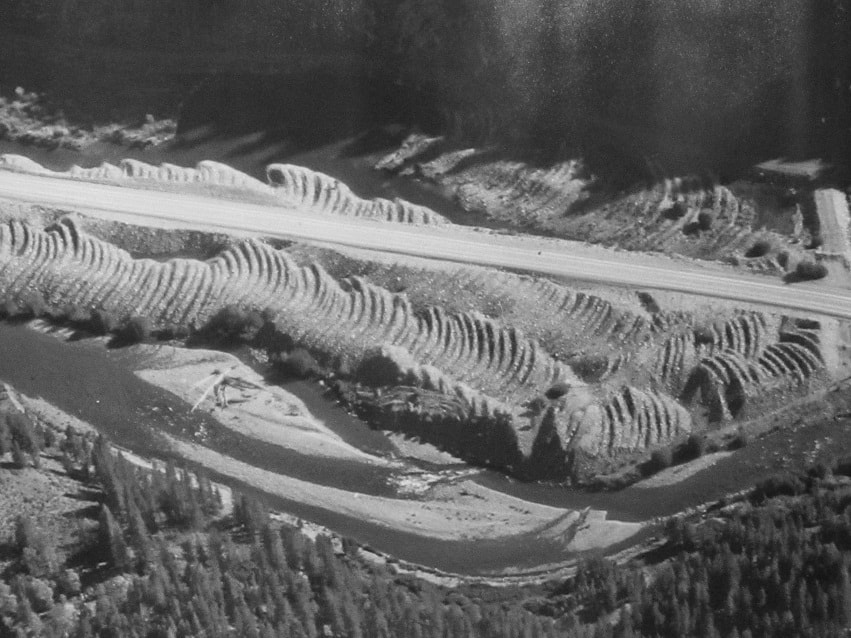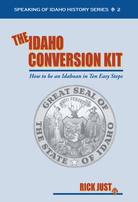When you think of a miner, you probably picture some old Gabby Hayes character with a pinned back hat brim crouched over a stream with a pan, dreams of gold glittering in his eye. That’s not a bad picture of a prospector, because most miners (some of whom were also minors) started out that way. Panning for gold is slow and tedious. Shake, shake, shake, rinse, shake, shake, shake, rinse, and repeat until your beard grows down to your waist. Gold flecks are heavier than most of the surrounding material so they sink to the bottom of the pan. A good panner could sift through about a yard of sand and gravel a day. If they turned up $3 or $4 worth of gold, that was excellent. It was about what they might make for a day as, say, a captain in the army in the 1860s, or your average bricklayer in the East.
But miners did not dream of bricklayer wages. They wanted more. That’s why prospectors were typically testing the waters, so to speak, in search of a vein higher upstream. Let’s assume for a moment that they couldn’t find that ledge of quartz, but the quantity of gold in the stream gravel was pretty good. They were stuck with mining the streambed itself or an alluvial fan where water once ran. That’s called “placer mining.” In that case they needed a way to sift more sand and gravel faster in order to have more gold at the end of the day.
Rockers were boxes into which the miner dumped gravel and sand scooped from a stream bottom or alluvial deposit. At the top of the box was a sieve where the larger bits of gravel were screened out. Below that was an incline set up with a series of bumps or ribs down the length of the box over which sand would run when the worker poured water into the device while rocking it back and forth, the equivalent of shaking a gold pan. A piece of draping canvas helped filter out the gold from the lighter stuff. Rockers were especially useful if the material a miner was working with was partially cemented, meaning sticky clay had to be washed away. A good rocker operator could triple his day’s take over panning, meaning he was up close to what a major general might make.
Still, it was pretty tedious work and the miner was not making the fortune he was dreaming of. A faster production method was called for.
The quickest way to pull gold out of a streambed for one or two men was a sluice running into a rocker. The downside was that you needed a downside. That is, you needed some elevation for water to pick up some speed to wash over the material you were working. Sometimes that meant digging a ditch, which was a lot of work. A sluice was only practical if the bits of gold were fairly large. Gold “dust” would float right out.
A sluice running through a giant could handle 500 yards of gravel a day, compared with that one yard a man with a pan could process. That meant a miner could work material that was a lot less rich and still pull much more gold out in a day.
This sloshing escalation of mining methods could be carried to ends that a single miner couldn’t handle, such as hydraulic mining and large-scale dredging.
No matter the method, the idea behind placer mining was to rinse away the rubble and expose the gold in the remaining sand. It’s a fairly benign operation at the lower end of the scale, but the more material an operation uses the more a streambed or ancient deposit is disturbed. See the aerial below of the windrows of gravel left by the Yankee Fork Dredge.
But miners did not dream of bricklayer wages. They wanted more. That’s why prospectors were typically testing the waters, so to speak, in search of a vein higher upstream. Let’s assume for a moment that they couldn’t find that ledge of quartz, but the quantity of gold in the stream gravel was pretty good. They were stuck with mining the streambed itself or an alluvial fan where water once ran. That’s called “placer mining.” In that case they needed a way to sift more sand and gravel faster in order to have more gold at the end of the day.
Rockers were boxes into which the miner dumped gravel and sand scooped from a stream bottom or alluvial deposit. At the top of the box was a sieve where the larger bits of gravel were screened out. Below that was an incline set up with a series of bumps or ribs down the length of the box over which sand would run when the worker poured water into the device while rocking it back and forth, the equivalent of shaking a gold pan. A piece of draping canvas helped filter out the gold from the lighter stuff. Rockers were especially useful if the material a miner was working with was partially cemented, meaning sticky clay had to be washed away. A good rocker operator could triple his day’s take over panning, meaning he was up close to what a major general might make.
Still, it was pretty tedious work and the miner was not making the fortune he was dreaming of. A faster production method was called for.
The quickest way to pull gold out of a streambed for one or two men was a sluice running into a rocker. The downside was that you needed a downside. That is, you needed some elevation for water to pick up some speed to wash over the material you were working. Sometimes that meant digging a ditch, which was a lot of work. A sluice was only practical if the bits of gold were fairly large. Gold “dust” would float right out.
A sluice running through a giant could handle 500 yards of gravel a day, compared with that one yard a man with a pan could process. That meant a miner could work material that was a lot less rich and still pull much more gold out in a day.
This sloshing escalation of mining methods could be carried to ends that a single miner couldn’t handle, such as hydraulic mining and large-scale dredging.
No matter the method, the idea behind placer mining was to rinse away the rubble and expose the gold in the remaining sand. It’s a fairly benign operation at the lower end of the scale, but the more material an operation uses the more a streambed or ancient deposit is disturbed. See the aerial below of the windrows of gravel left by the Yankee Fork Dredge.
This 19th century engraving shows a miner using a rocker box at a streamside. He would dump sand and gravel in the top, then pour water through it to rinse the material.
Aerial view of the gravel windrows left by the Yankee Fork Dredge. The Yankee Fork dumps into the Main Salmon near Sunbeam.






 RSS Feed
RSS Feed